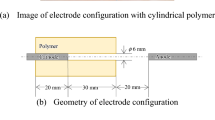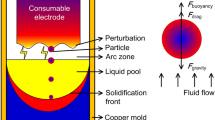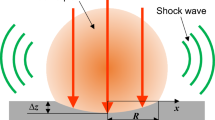Abstract
The paper deals with the numerical simulation on polymer ablation phenomena during electric arc ignition process. The calculations from particle composition of high-temperature polymer vapor to the electromagnetic thermofluid simulation were consistently performed.
In the present paper, first, methods and calculation results of the particle compositions and the thermodynamic and transport properties of polymer vapors were described. Using the particle composition calculated, thermodynamic and transport properties and radiation power were also obtained, and subsequently the electromagnetic thermofluid simulation was performed with a model of one-side flow outlet. The calculation results showed the temporal changes in the arc temperature distribution and the mass fraction distribution of mixed polymer vapor for various polymer materials of PA6, POM and PTFE. The differences in time required for ablation and the results of particle composition, thermodynamic and transport properties calculated were discussed. In the present calculation, POM showed the best properties such as the highest arc voltage among the three polymers, which can be explained by the high ablation rate and characteristics of thermal conductivity of POM vapor contaminated arc.












Similar content being viewed by others
Data Availability
All the materials is owned by the authors and/or no permissions are required.
References
Regulation (EU) No.517/2014
Owens J, Xiao A, Bonk J, DeLorme M, Zhang A (2021) Recent development of two alternative gases to SF6 for high voltage electrical power applications. Energies 14:5051
Tsukima M, Mitsuhashi T, Takahashi M, Fushimi M, Hosogai S, Yamagata S (2002) Low-voltage circuit breaker using auto-puffer interruption technique. IEEJ Trans Power Energy 122(9):969–975 ((in Japanese))
Taxt H 2015 Ablation-assisted current interruption in medium voltage switchgear – development and prospects. In: 24th Nordic insulation symposium on materials, components and diagnostics, 38–43
Ruchti CB, Niemeyer L (1986) Ablation controlled arcs. Trans Plasma Sci 14:433–434
Becerra M, Pettersson J (2018) Optical radiative properties of ablating polymers exposed to high-power arc plasmas. J Phys D Appl Phys 51:125202
Domejean E, Chevrier P, Fievet C, Petit P (1997) Arc-wall interaction modelling in a low-voltage circuit breaker. J Phys D Appl Phys 30:2132–2142
Nossov V, Hage B, Jusselin B, Fiévet C (2007) Simulation of the thermal radiation effect of an arc on polymer walls in low-voltage circuit breakers. Tech Phys 52:651–659
Ma Q, Rong M, Murphy AM, Wu Y, Xu T (2009) Simulation study of the influence of wall ablation on arc behavior in a low-voltage circuit breaker. IEEE Trans Plasma Sci 37:261–269
Nakagawa T, Nakano T, Tanaka Y, Uesugi Y, Ishijima T (2015) Numerical simulation on dynamics and thermal decomposition of spallation polymer particles flying in polymer ablated arcs. IEEJ Trans Power Energy 135(11):1–7
Huo J, Selezneva S, Jacobs L, Cao Y (2019) Study on wall ablation on low-voltage arc interruption: the effect of Stefan flow. J Appl Phys 125:213302
Godin D, Trépanier JY, Reggio M, Zhang XD, Camarero R (2000) Modelling and simulation of nozzle ablation in high-voltage circuit-breakers. J Phys D 33:2583
Martin A, Trepanier JY, Reggio M, Xueyan G (2007) Transient ablation regime in circuit breakers. Plasma Sci Technol 9:653
Osawa N, Yoshioka Y (2010) Analysis of nozzle ablation characteristics of gas circuit breaker. IEEE Trans PWRD 25(2):755–761
Eichhoff D, Kurz A, Kozakov R, Gött G, Uhrlandt D, Schnettler A (2012) Study of an ablation-dominated arc in a model circuit breaker. J Phys D Appl Phys 45:305204
Bu WH, Fang MTC, Guo ZY (1990) The behaviour of ablation-dominated DC nozzle arcs. J Phys D Appl Phys 23:175–183
Zhang JL, Yan JD, Murphy AB, Hall W, Fang MTC (2002) Computational investigation of arc behavior in an auto-expansion circuit breaker contaminated by ablated nozzle vapor. IEEE Trans Plasma Sci 30(2):706–719
Seeger S, Niemeyer L, Christen T, Schwinne M, Dommerque R (2006) An integral arc model for ablation controlled arcs based on CFD simulations. J Phys D Appl Phys 39:2180–2191
White WB, Johnson SM, Danzing GB (1958) Chemical equilibrium in complex mixtures. J Chem Phys 28:751–755
Chase MW (1998) NIST-JANAF Thermochemical tables, 4th edn. Society and the American Instituteof Phys, The American Chem
Champman S, Cowling TG (1970) The mathematical theory of non-uniform gases, 3rd edn. Cambridge University Press
Tanaka Y, Yamachi N, Matsumoto S, Kaneko S, Okabe S, Shibuya M (2008) Thermodynamic and transport properties of CO2, CO2–O2, and CO2–H2 mixtures at temperatures of 300 to 30,000 K and pressures of 01 to 10 MPa. Electr Eng Japan 163(4):19–29
Yos JM. 1967 Transport properties of nitrogen, hydrogen, oxygen and air to 30000 K, Research and Advanced Development Division AVCO Corporation, Massachusetts, Amendments to AVCO RAD-TM-63–7.
Abrahamson AA (1969) Born-Mayr-type interatomic potential for neutral ground-state atoms with Z = 2 to Z= 105. Phys Rev 178:76–79
Monchick L (1959) Collision integrals for the exponential repulsive potential. Phys Fluids 2:695–700
Hirschfelder JO, Curtiss CF, Bird RB (1968) Molecular theory of gases and liquids. John Wiley and Sons, p 168
National Institute of Standards and Technology, Physical Measurement Laboratory http://www.nist.gov/pml/data/asd.cfmAuthor, F.: Article title. Journal 2(5), 99–110 (2016)
Tanaka Y, Sakuta T (2002) Investigation on plasma-quenching efficiency of various gases using the inductively coupled thermal plasma technique: effect of various gas injection on Ar thermal ICP. J Phys D Appl Phys 35:2149
Hajossy R, Morva I (1994) Cathode and anode falls of arcs with fusible electrodes. J Phys D Appl Phys 27:2095–2101
Lancaster JF (1954) Energy distribution in argon-shielded welding arcs. Br Weld J 1:412
Funding
Not applicable.
Author information
Authors and Affiliations
Contributions
YN conducted to make calculations in the manuscript and wrote the main manuscript text and prepared all figures. YT supervised the conduct of this study. TI contributed to the interpretation of the results and expressions in the draft. All the contents were discussed by all authors together. The manuscript was reviewed by all authors.
Corresponding author
Ethics declarations
Competing interests
The authors have no competing interests as defined by Springer, or other interests that might be perceived to influence the results and/or discussion reported in this paper.
Additional information
Publisher's Note
Springer Nature remains neutral with regard to jurisdictional claims in published maps and institutional affiliations.
Rights and permissions
Springer Nature or its licensor (e.g. a society or other partner) holds exclusive rights to this article under a publishing agreement with the author(s) or other rightsholder(s); author self-archiving of the accepted manuscript version of this article is solely governed by the terms of such publishing agreement and applicable law.
About this article
Cite this article
Nakano, Y., Tanaka, Y. & Ishijima, T. Consistent Calculation from Particle Composition to Arc Simulation for Arc Ignition Process in Polymer Ablated Arcs. Plasma Chem Plasma Process 44, 1–24 (2024). https://doi.org/10.1007/s11090-023-10360-9
Received:
Accepted:
Published:
Issue Date:
DOI: https://doi.org/10.1007/s11090-023-10360-9




